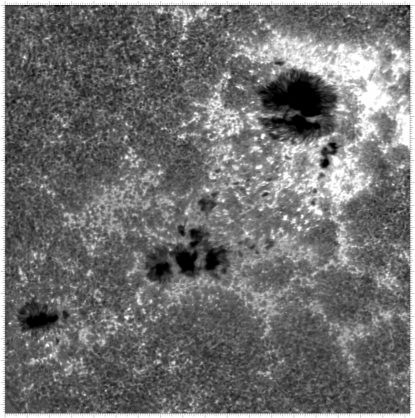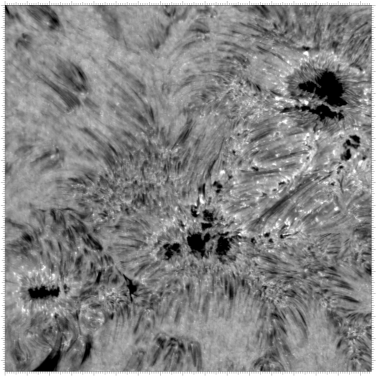Here are some first-light images from the new solar telescope.
"First light" is a mainly ceremonial event, that demonstrates the function of a new telescope. The very first images collected with the telescope demonstrate that the design, the alignment and the control systems are good. The images do not show the ultimate abilities of the telescope since we do not yet have adaptive optics on line the 96 cm aperture is stopped down to 60 cm (we want to test the cooling system thoroughly before allowing sunlight through the full aperture), and the Schupmann corrector is not installed yet.
The images shown below are of a group of sunspots in two different wavelengths. Light in different wavelengths originate from different heights in the solar atmosphere at different rates. Thus, images taken in different wavelengths have information from different heights.
These images were taken with the new solar telescope which is operated on the island of La Palma by the Royal Swedish Academy of Sciences in the Spanish Observatorio del Roque de los Muchachos of the Instituto de Astrofisica de Canarias.

This image was taken using a filter that isolates the so called Ca K spectral line - light that is emitted by ionised calcium atoms. This light originates from the lower chromosphere which lies above the visible surface of the sun. The bright regions around the sunspots are called "plage" and has since long been known as a sign of enhanced magnetic fields. The exact mechanism causing this phenomenon is still uncertain, however. In the sunspots the magnetic field is so strong that the energy transport from the hot solar interior is hindered. That is why they look dark.
The image is available at a number of different resolutions: 405×408 pixels (170 Kbytes) 506×510 pixels (260 Kbytes) 2025×2041 pixels (2.5 Mbytes - BIG)

This image is taken using a filter that isolates the so called H-alpha spectral line - light that is emitted by hot hydrogen gas. This light originates from the upper chromosphere which lies high above the visible surface of the sun. The threaded structures show the arrangement of magnetic fields, showing that these emanate from the sunspots.
The image is available at a number of different resolutions: 366×366 pixels (150 Kbytes) 458×458 pixels (230 Kbytes) 1832×1832 pixels (2 Mbytes - BIG)